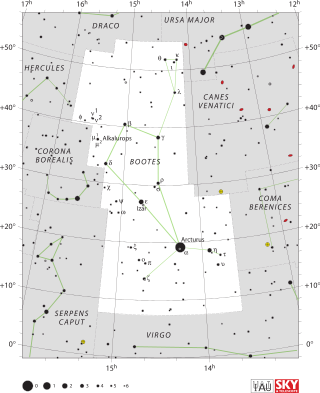Top Qs
Timeline
Chat
Perspective
Iota Boötis
Binary star system in the constellation of Boötes From Wikipedia, the free encyclopedia
Remove ads
Iota Boötis is a wide binary star system in the constellation Boötes, approximately 96 light-years from Earth. Its name is a Bayer designation that is Latinized from ι Boötis, and abbreviated Iota Boo or ι Boo. The brighter component has the traditional name Asellus Secundus, pronounced /əˈsɛləs sɪˈkʌndəs/, which is Latin for "second donkey colt", and the Flamsteed designation 21 Boötis.[13] It is faintly visible to the naked eye with a typical apparent visual magnitude of +4.75.[2] Based on parallax measurements, it is located at a distance of 96 light-years (29 pc) from the Earth. The star is drifting closer to the Sun with a radial velocity of −19 km/s.[7]

The companion is HD 234121, a K-type main-sequence star at an angular distance of 38.6 arcseconds; easily separated with binoculars.
Remove ads
Components

The primary component is a white hued A-type main-sequence star with a stellar classification of A7V.[4] It is classified as a Delta Scuti-type variable star and its brightness varies from magnitude +4.73 to +4.78 with a stable period of 38 minutes.[8] This star is 785[1] million years old and has a high rate of spin, showing a projected rotational velocity of 144 km/s.[10] It has 1.8[4] times the mass of the Sun and 1.7 times the Sun's radius.[1] Iota Boötis is radiating 8.8[1] times the luminosity of the Sun from its photosphere at an effective temperature of 7,764 K.[1]
The common proper motion companion, HD 234121, is a magnitude 7.3 main-sequence star belonging to spectral class K0V.[5][15] It has a projected separation from ι Boo of 1,100 AU.[4] HD 234121 has a mass of 0.8 M☉, a luminosity of 0.4 L☉, a temperature of 5,090 K, and a radius of 0.8 R☉.[11]
The Washington Double Star Catalog lists a third component, a 14th-magnitude star at 90 arcseconds,[15] but it is an unrelated background star.[16]
Remove ads
Nomenclature
This star, along with the other Aselli (θ Boo and κ Boo) and λ Boo, were Aulād al Dhiʼbah (أولاد الضّباع - awlād al-ḍibā‘), "the Whelps of the Hyenas".[the transcription does not match the Arabic][17]
In Chinese, 天槍 (Tiān Qiāng), meaning Celestial Spear, refers to an asterism consisting of ι Boötis, κ2 Boötis and θ Boötis.[18] Consequently, the Chinese name for ι Boötis itself is 天槍二 (Tiān Qiāng èr, English: the Second Star of Celestial Spear).[19]
Remove ads
References
External links
Wikiwand - on
Seamless Wikipedia browsing. On steroids.
Remove ads

